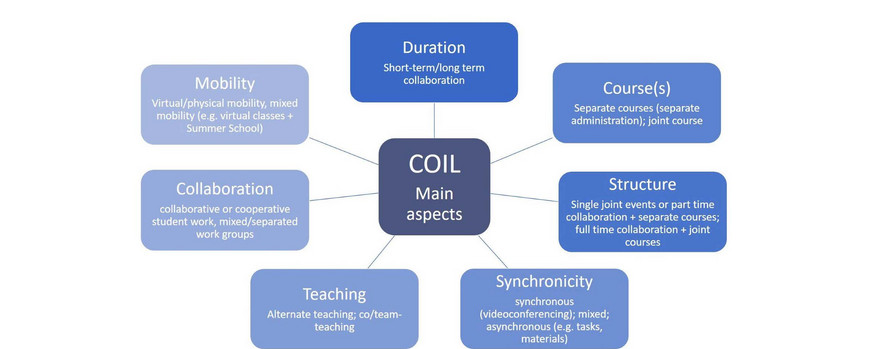Scenarios
The COIL format as a way of international teaching is often linked to the presence of specific didactic, organizational, and technical features.
In line with our goal of helping to shape and promote the internationalization of teaching across the board, we also take a broad view and consider all formats of international exchange in teaching and learning. In addition to classic COIL courses, individual events, guest lectures in seminars or block courses also offer the opportunity to gain international experience.
Each teaching cooperation is unique in its design. An initial approach to the broad spectrum is provided by classic cooperation formats and central aspects that play an important role in planning and conception.
Two COIL formats
Short-term cooperation (Pre-COIL)
So-called Pre-COIL formats offer a good starting point of internationalizing one's own teaching. Guest lectures by experts within the framework of a course or events of limited duration such as (half-)day events or individual joint sessions with courses and seminar groups from external universities offer teachers and students a low-threshold opportunity to gain initial experience with teaching and learning in international exchange.
The advantage here is the low effort in terms of time and organization since existing course concepts do not have to be changed fundamentally. The integration of question/discussion rounds or short cooperative activities and the use of partly well-known and easy-to-use digital tools (videoconferencing, LMS, chats) enriches the own course. In doing so, the collaborative elements and activities often take place outside of contact time. Tandems or small groups work self-organized (if necessary, with tutorial support) on tasks and create learning products such as discussion contributions, posters, presentations or similar.
Longer-term cooperations (Full-COIL)
Cooperations that last for a period of several weeks or over a whole semester offer a greater scope in terms of activities and methods and the opportunity to gain more diverse and in-depth experiences in international and intercultural exchange. Students work both synchronously and asynchronously in small groups on longer-term projects, exchange ideas intensively in self-organized (or facilitated) virtual meetings and work together on learning products. In addition to collaboration, the presentation, documentation, and reflection of the joint work are important components of the Full-COIL format. Planning and conceptionalising longer-lasting collaborations, fulfilling all prerequisites for diverse online activities, creating learning material, enabling a digital learning environment as well as implementing and monitoring the course all represent a greater effort on behalf of both the teachers and the students. However, experience has shown that all participants benefit from such scenarios to a very special degree.
Main aspects of COIL scenarios
Each COIL project is unique in its form and implementation, depending on the specific characteristics and design of some key aspects. These main aspects must be considered in the later conception of cooperative teaching, but they can give a broad initial overview over different COIL scenarios already at the beginning.

